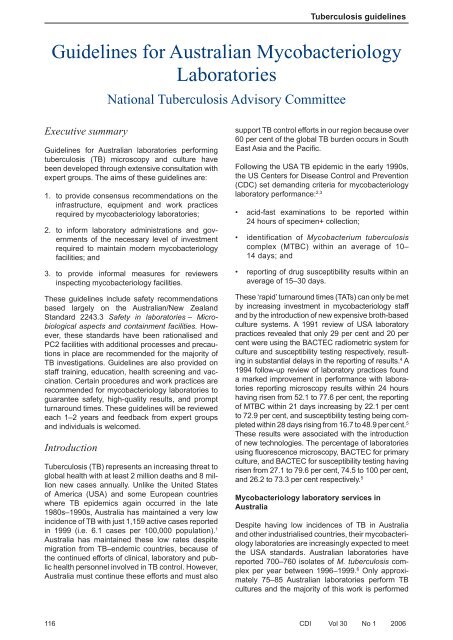PDF file - Department of Health and Ageing
PDF file - Department of Health and Ageing
PDF file - Department of Health and Ageing
Create successful ePaper yourself
Turn your PDF publications into a flip-book with our unique Google optimized e-Paper software.
Tuberculosis guidelines<br />
Guidelines for Australian Mycobacteriology<br />
Laboratories<br />
National Tuberculosis Advisory Committee<br />
Executive summary<br />
Guidelines for Australian laboratories performing<br />
tuberculosis (TB) microscopy <strong>and</strong> culture have<br />
been developed through extensive consultation with<br />
expert groups. The aims <strong>of</strong> these guidelines are:<br />
1. to provide consensus recommendations on the<br />
infrastructure, equipment <strong>and</strong> work practices<br />
required by mycobacteriology laboratories;<br />
2. to inform laboratory administrations <strong>and</strong> governments<br />
<strong>of</strong> the necessary level <strong>of</strong> investment<br />
required to maintain modern mycobacteriology<br />
facilities; <strong>and</strong><br />
3. to provide informal measures for reviewers<br />
inspecting mycobacteri ology facilities.<br />
These guidelines include safety recommend ations<br />
based largely on the Australian/New Zeal<strong>and</strong><br />
St<strong>and</strong>ard 2243.3 Safety in laboratories – Microbiological<br />
aspects <strong>and</strong> containment facilities. However,<br />
these st<strong>and</strong>ards have been rationalised <strong>and</strong><br />
PC2 facilities with additional processes <strong>and</strong> precautions<br />
in place are recommended for the majority <strong>of</strong><br />
TB investigations. Guidelines are also provided on<br />
staff training, education, health screening <strong>and</strong> vaccination.<br />
Certain procedures <strong>and</strong> work practices are<br />
recommended for mycobacteriology laboratories to<br />
guarantee safety, high-quality results, <strong>and</strong> prompt<br />
turnaround times. These guidelines will be reviewed<br />
each 1–2 years <strong>and</strong> feedback from expert groups<br />
<strong>and</strong> individuals is welcomed.<br />
Introduction<br />
Tuberculosis (TB) represents an increasing threat to<br />
global health with at least 2 million deaths <strong>and</strong> 8 million<br />
new cases annually. Unlike the United States<br />
<strong>of</strong> America (USA) <strong>and</strong> some European countries<br />
where TB epidemics again occurred in the late<br />
1980s–1990s, Australia has maintained a very low<br />
incidence <strong>of</strong> TB with just 1,159 active cases reported<br />
in 1999 (i.e. 6.1 cases per 100,000 population). 1<br />
Australia has maintained these low rates despite<br />
migration from TB–endemic countries, because <strong>of</strong><br />
the continued efforts <strong>of</strong> clinical, laboratory <strong>and</strong> public<br />
health personnel involved in TB control. However,<br />
Australia must continue these efforts <strong>and</strong> must also<br />
support TB control efforts in our region because over<br />
60 per cent <strong>of</strong> the global TB burden occurs in South<br />
East Asia <strong>and</strong> the Pacifi c.<br />
Following the USA TB epidemic in the early 1990s,<br />
the US Centers for Disease Control <strong>and</strong> Prevention<br />
(CDC) set dem<strong>and</strong>ing criteria for mycobacteriology<br />
laboratory performance: 2,3<br />
• acid-fast examinations to be reported within<br />
24 hours <strong>of</strong> specimen+ collection;<br />
• identification <strong>of</strong> Mycobacterium tuberculosis<br />
complex (MTBC) within an average <strong>of</strong> 10–<br />
14 days; <strong>and</strong><br />
• reporting <strong>of</strong> drug susceptibility results within an<br />
average <strong>of</strong> 15–30 days.<br />
These ‘rapid’ turnaround times (TATs) can only be met<br />
by increasing investment in mycobacteriology staff<br />
<strong>and</strong> by the introduction <strong>of</strong> new expensive broth-based<br />
culture systems. A 1991 review <strong>of</strong> USA laboratory<br />
practices revealed that only 29 per cent <strong>and</strong> 20 per<br />
cent were using the BACTEC radiometric system for<br />
culture <strong>and</strong> susceptibility testing respectively, resulting<br />
in substantial delays in the reporting <strong>of</strong> results. 4 A<br />
1994 follow-up review <strong>of</strong> laboratory practices found<br />
a marked improvement in performance with laboratories<br />
reporting microscopy results within 24 hours<br />
having risen from 52.1 to 77.6 per cent, the reporting<br />
<strong>of</strong> MTBC within 21 days increasing by 22.1 per cent<br />
to 72.9 per cent, <strong>and</strong> susceptibility testing being completed<br />
within 28 days rising from 16.7 to 48.9 per cent. 5<br />
These results were associated with the introduction<br />
<strong>of</strong> new technologies. The percentage <strong>of</strong> laboratories<br />
using fluorescence microscopy, BACTEC for primary<br />
culture, <strong>and</strong> BACTEC for susceptibility testing having<br />
risen from 27.1 to 79.6 per cent, 74.5 to 100 per cent,<br />
<strong>and</strong> 26.2 to 73.3 per cent respectively. 5<br />
Mycobacteriology laboratory services in<br />
Australia<br />
Despite having low incidences <strong>of</strong> TB in Australia<br />
<strong>and</strong> other industrialised countries, their mycobacteriology<br />
laboratories are increasingly expected to meet<br />
the USA st<strong>and</strong>ards. Australian laboratories have<br />
reported 700–760 isolates <strong>of</strong> M. tuberculosis complex<br />
per year between 1996–1999. 6 Only approximately<br />
75–85 Australian laboratories perform TB<br />
cultures <strong>and</strong> the majority <strong>of</strong> this work is performed<br />
116 CDI Vol 30 No 1 2006
















